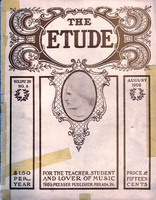I am frequently asked by pupils, correspondents, and people whom I meet which kind of shoes I recommend for organ-pedaling. I am generally inclined to quote a little slang and reply: “Oh, any old shoe.” Now, this may be slang, but it expresses more than one would suppose, as any new shoe would be the worst kind of a shoe to wear when attempting any difficult pedal passage, while a shoe that is half worn out, provided the heels are not too much worn off at the back or sides, enables one to use the feet in pedaling with greater ease and flexibility. Whether the shoe is buttoned, laced, or of the Congress pattern is purely a matter of taste.
Occasionally one meets an organist who prefers a low shoe, and I once met an organist (?) who “could not play” unless he wore his patent-leather slippers. The objection to slippers and an objection to low shoes, though less in the case of the latter, is that they slip at the heal.
I am inclined to think that too much stress is put upon the subject by would-be organists, and that it is only necessary to stick to some one kind of a shoe, as changing from high to low, from heavy to light, or from new to old will cause more inconvenience than is at first thought.
Of course, rubber soles or heels are out of the question as being entirely objectionable, and the quasistylish shoe of to-day, which has the soles projecting from a quarter of an inch to a half an inch, cannot be worn without inconvenience. Likewise the heavy winter shoes, with stiff soles a half-inch or more thick, are not desirable.
Personally, I prefer a light, thin-soled shoe (buttoned or laced) which has been worn in walking for a month or more and is thus flexible and easy to the foot. The heels must be kept square, else the difficulty of many pedal passages is increased.



